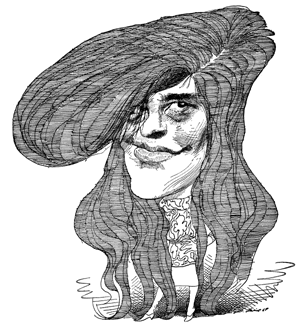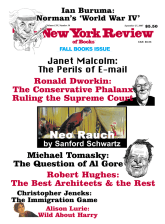In response to:
Notes on Susan from the August 16, 2007 issue
To the Editors:
Eliot Weinberger’s article [“Notes on Susan,” NYR, August 16] on the posthumous collection of Susan Sontag’s last writings and speeches, which her publisher Farrar, Straus and Giroux recently issued, is certainly an informative overview of the late writer’s work, and yet it comes off as a putdown, or more precisely, a critique with an agenda. Brimming with opinions and assumptions—notably his dismissal of her groundbreaking essay “Notes on Camp”—his appraisal often seems capricious, trivializing, as if putting the deceased critic in her place, literally, six feet under. For Mr. Weinberger, Sontag ultimately belongs more to “literary history than to literature”—one of several categorical statements he makes which are oddly devoid of content. The first sentence is telling in this regard: “Susan Sontag was that unimaginable thing, a celebrity literary critic.” In our age when all is hype and appearance, a celebrity literary critic is, if not as common as the latest movie star, certainly not “unimaginable.” Fashion and quality go hand in hand like oil and water, as Jorge Luis Borges ferociously reminded his interlocutors on more than one occasion, but this does not mean that intellectual celebrities do not abound.
“Notes on Camp,” according to Weinberger, has “dated badly.” He gives as one of his reasons that camp (which has a complex cultural history he summarizes as “the French had been doing it for years”) has “long since reverted to its summer leisure connotations, and its subtleties, so meticulously detailed by Sontag, have been reduced to the ‘Cult’ section of the video store” (my italics). Whether or not baby boomers like Mr. Weinberger have become more conservative vis-à-vis alternative lifestyles over the decades, camp, signifying objects and behavior as well as a primarily but not only gay aesthetic sensibility, has not lost its relevance to today’s culture.
On the contrary, unperceived camp has become, unfortunately, what our culture produces, not to mention our way of life. To cite the 1961 essay that Weinberger reduces to Sontag’s “fifty-three-point structuralist analytic overkill on a minor pop phenomenon,” camp is “the exaggerated, the ‘off’…things-being-what-they-are-not.” A minor pop phenomenon? In today’s world, more than ever, artifice reigns supreme, from cyberspace and the media takeover to its many tasteless and larger-than-life products. “Camp is the attempt to do something extraordinary”: again Sontag’s words remain prophetic: we live in a world of complete hyperness. Camp has largely taken over—to the point that very few are capable of maintaining sufficient lucidity to recognize its pervasive presence—in politics, in art, and in the marketplace, about which Sontag was most discerning.
So sensitive to the crank in Sontag as the American proselytizer of Roland Barthes, Weinberger seems unaware of his own cranky stances. For example, he proceeds to empower the essay, after reducing it to trivia, with a grouchy assumption about academe, one of his pet peeves: “From that seed, to her dismay, grew the vine that would eventually overrun the English Department, producing a thousand deconstructionist dissertations on Batman.” Quite a leap. In a colloquium at UC Berkeley, over fifteen years ago, in which the implied subject was the survival (or not) of the humanities, Weinberger first mentioned Batman as a field of study as a quip about the “cultural studies” takeover of the humanities, which would finalize the job begun by the various reigns of terror by the successive theoretical schools which buried New Criticism. This appropriation had nothing to do with Sontag’s essay—which, true to form, asserted aesthetic values over all others—and everything to do with the strategies of the social sciences to dominate academic discourse.
Whatever may be Weinberger’s reason to place Batman in Sontag’s camp, so to speak, his article is plagued by other such lapses attributing academe’s—or rather his ranting metonym the English Department’s—worse sins to the deceased critic. I only wish he could have made these assertions when she was still among us; the dialogue might have been illuminating. When acknowledging Sontag’s lucid focus on the movies as a serious topic for “highbrow” literary critics, referring to cinema as “the art of the twentieth century” (Weinberger mocks her use of italics), he establishes the following quaint genealogy: “her example had paved the way for the strange idea and practice of the incorporation of Film Studies into the English Department.”
Why is the study of films, I wonder, which after all are artworks with a verbal and textual dimension, any stranger than the numerous subject matters taught in literature programs today which have nothing to do with aesthetics? But even more offtrack: Was Susan Sontag really the first literary critic to discuss film as a total art form and hence to bring it to the attention of academic discourse? Some of us have memories of a number of world-class intellectuals such as Rudolph Arnheim and Barthes himself who preceded her.
Advertisement
Though he is fair in his considerations of her so-called “serious work” (Illness as Metaphor, On Photography), Weinberger consistently trivializes Sontag; he praises her critical writing on individual artists and intellectual figures only to downgrade, in the same breath, her work on “larger tropes” even when those tropes, which—granted—she may have imported from Europe and especially Barthes, did make a difference in our cultural landscape.
Suzanne Jill Levine
Director of Translation Studies
University of California at Santa Barbara
Santa Barbara, California
To the Editors:
In his recent review of Susan Sontag, Eliot Weinberger makes the following observation about her review of the great Icelandic writer Halldór Laxness:
With Halldór Laxness’s Under the Glacier, she seems far off her turf, contextualizing as best she can with everything from Steppenwolf to Buster Keaton. (And disbelief does not get willingly suspended when she declares, twice, that this book is “like nothing else Laxness ever wrote,” considering that he produced some sixty novels, most of them as yet untranslated from the Icelandic.)
While I applaud Mr. Weinberger’s plea for the avoidance of impossibly sweeping critical judgments, he has quadrupled Laxness’s oeuvre. There are something like fifteen Laxness novels, most of which indeed have appeared in English.
Brad Leithauser
Amherst, Massachusetts
To the Editors:
In Eliot Weinberger’s article “Notes on Susan,” I was shocked to read the following assertion: “That we now live in an era where presidential candidates and their wives openly discuss their cancer, complete with medical diagrams in the newspapers, is the result of a shift in thinking that clearly began with Sontag’s book [Illness as Metaphor, 1978].”
That statement is simply wrong: the shift in thinking began four years earlier, when a far more widely known woman, Betty Ford, spoke publicly about her own experience with breast cancer. Mrs. Ford set a pattern of openness that continues to this day, and it is most unfair to overlook the influence she has had.
I also must comment on Mr. Weinberger’s citation of Sontag’s September 11 article in The New Yorker. He talks about Sontag being assailed in an atmosphere of “jingoism” for writing “Let’s by all means grieve together. But let’s not be stupid together.” One does not have to be a jingoist to be offended by that statement. Any intelligent reader can see that Sontag felt no grief whatsoever, and was impatient with those who did. It’s ironic that the woman who wrote the first-rate book Regarding the Pain of Others seemed so unable to sympathize or even grasp the pain of those others who were just forty blocks south of her home.
Jane Farrell
Peoria, Arizona
To the Editors:
Eliot Weinberger’s discussion of Susan Sontag’s “unashamed” Eurocentrism scants consideration of her taste in cinema, an art she loved as much as literature, and thereby diminishes it. Sontag’s late admiration for the films of Hungary’s Béla Tarr, Germany’s Fred Keleman, and Russia’s Alexander Sokurov can certainly be traced to her adherence to the European modernist cinema of the Sixties. However, her capacious—one might say rapacious!—interest in film led her also to champion the work of contemporary Taiwanese directors Edward Yang and Hou Hsiao-hsien, Iranian master Abbas Kiarostami, and the little-known Japanese documentarist Kazuo Hara.
Sontag was widely appreciated as something of an expert in classic and new wave Japanese cinema, tutored by her old friend and authority in the field Donald Richie. She was always eager for tips on discoveries, from any decade and any country, Belgium, Burkino Faso, or Kazakhstan, and her intense curiosity was shadowed by self-doubt about some of her long-held opinions on such matters as Syberberg’s Our Hitler and the late films of Jean-Luc Godard and Robert Bresson. As for American cinema, she knew her Mamoulian, came to admire Sirk, praised Kenneth Anger and Jack Smith, and had an appreciation for screwball comedy.
James Quandt
Senior Programmer
Cinematheque Ontario
Toronto, Ontario
Eliot Weinberger replies:
Thanks to Brad Leithauser for his correction. My misinformation came from Sontag herself (At the Same Time, p. 98). She thought Laxness wrote sixty novels, so her assertion of the uniqueness of Under the Glacier remains somewhat presumptuous. As far as I can tell, nine of Laxness’s fifteen novels have been translated. Untranslated are eleven collections of short stories and some twenty-odd other books.
Jane Farrell quite rightly recalls Betty Ford’s courageous act. Sontag, a few years later, provided the intellectual ballast with her equally courageous dismantling of cancer as an image of anything other than itself, and as a psychological rather than strictly physiological disease.
It is good to have James Quandt’s personal recollections of Sontag’s cinephilia. I was dealing with her published books, and it is unfortunate that she never wrote on non-Western films, and very little on film at all after the 1970s.
Advertisement
My old friend Suzanne Jill Levine seems to be responding with more haste than care. I did not portion off some of Sontag’s writing as “serious work”—all of her work was serious. I did not categorize her as, or reduce her to, “the American proselytizer of Roland Barthes.” I did not say she was the first literary critic to write on film. My reference to the French was to their analyses of pop culture, not of camp. And, weirdly, I never attended a colloquium at UC Berkeley or anywhere else on the survival of the humanities, an academic discussion to which I have nothing to contribute, and I have never defended New Criticism. (Nor do I share Levine’s apparent conspiracy theory about the social sciences.)
To say, as I did, that camp pertains to a historical moment, is hardly a criticism of camp itself, let alone of “alternative life-styles.” Camp was a phenomenon forty years ago, largely among educated urban gay men. Today, the new generation of that same group is more likely to be picking up its kids from school than attending Joan Crawford festivals. Levine’s claim that camp now embraces the Internet, media take-overs, politics, etc., expands the concept to meaninglessness or an alarming frivolity. Rupert Murdoch and Dick Cheney are not camp.
In a half-sentence aside, I wondered why, at many universities, Film Studies is a subdivision of the English Department, and not a separate department, such as Music or Art History. This taxonomy strikes me as peculiar, and I speculated that perhaps it is a consequence of what were essentially literary analyses of films by Sontag and others in the 1960s and 1970s. This is not a criticism of Sontag, who had no active part in it, just as she had no active part in, and was appalled by, the now passé academic fad of subjecting pop culture to abstruse exegeses. Levine’s explanation that films are “art works with a verbal and textual dimension” is only partially true—countless scenes and many entire films have no words at all—and seems to reinforce the idea of film as literature’s poor cousin.
This Issue
September 27, 2007




